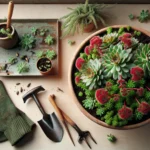Introduction to Sedum Cauticola
Embark on a horticultural journey with Sedum Cauticola, a gem among succulents that offers a lush palette for rock gardens and adds a touch of nature’s brilliance to even the most urban of spaces. A plant that’s both forgiving for beginners and satisfying for the seasoned green thumb, Sedum Cauticola embodies the perfect union of elegance and resilience.
Native to the rugged terrain of Japan, this succulent thrives in harsh conditions that would wither less hardy plants. Imagine a plant so versatile that it can bring life to stony outcrops and flourish in the crannies of stone walls—it’s no surprise that Sedum Cauticola is hailed as an ideal candidate for rock gardens or as a carefree ground cover.
Its intricate foliage, characterized by fleshy, rounded leaves that cascade into a dense, colorful mat, is not only attractive but is a triumph of adaptation. With leaves that can store water to outlast dry spells, Sedum Cauticola is a masterclass in drought tolerance. As seasons turn, watch this hardy perennial shift from blue-green hues to stunning shades of red and purple, a testament to its dynamic nature.
Whether it’s softening the edges of a stone pathway or basking in the glory of container gardens, Sedum Cauticola truly shines. Thanks to its easy-going personality, this succulent won’t demand constant attention, making it a perfect companion for those with a busy lifestyle or just dipping their toes in the art of gardening. And for the avid garden designer, it stands as a symbol of possibility, with its plush yet robust presence.
Discover more about the fascinating world of succulents and how to weave them into your life with our comprehensive guide on succulent care. Dive into a wealth of knowledge that will help you cultivate your green thumb and turn your space into an oasis of serenity and beauty.
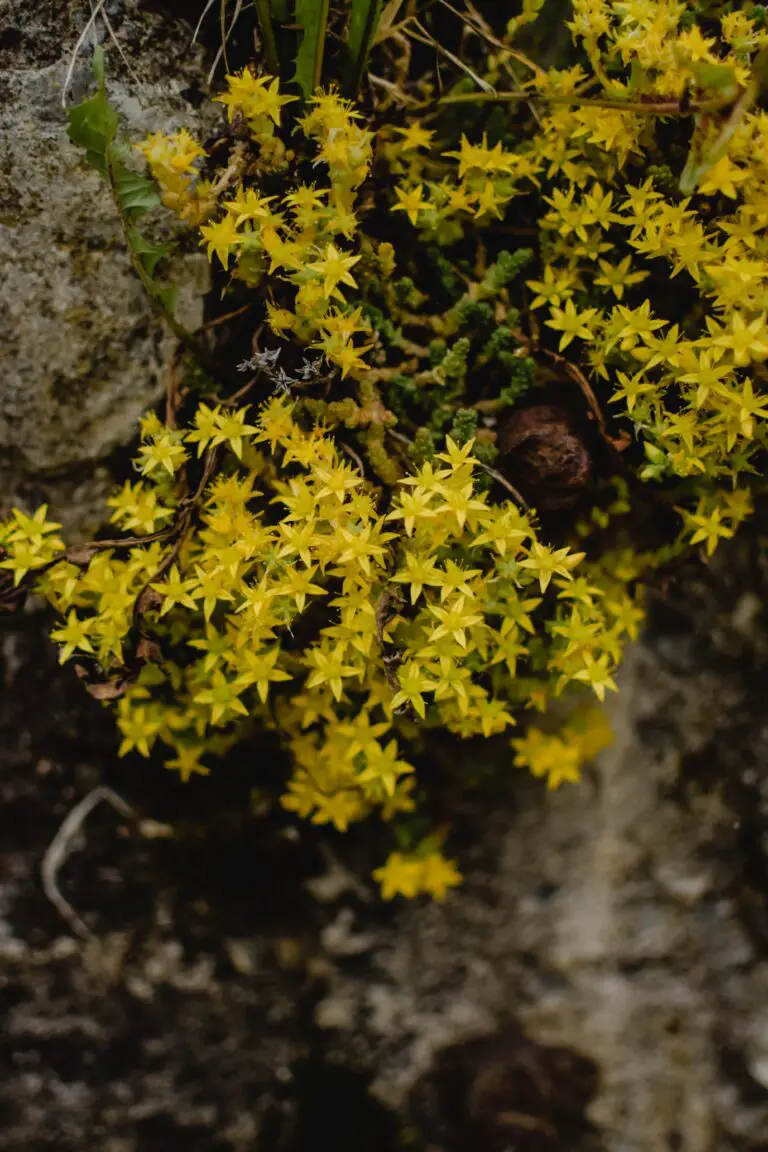
As an ambassador of low-maintenance gardening, Sedum Cauticola encourages us to rethink the traditional garden scape. Its ease of care and ability to thrive on neglect make it the ultimate plant for our modern, fast-paced world. Whether you’re a budding gardener or a busy bee looking to add a splash of green to your life, it’s time to uncover the secrets of Sedum Cauticola and embrace its potential to thrive in rock gardens and beyond.
Ideal Growing Conditions
Let’s cut to the chase. If you’re mesmerized by the dainty yet robust nature of Sedum Cauticola and are thinking about inviting this charmer into your rock garden or pot collection, knowing the nitty-gritty of its ideal environment is key. So, buckle up, because we’re about to explore just what makes this beauty thrive!
First on the list? Soil. Not just any dirt will do—Sedum Cauticola feasts on well-drained soil, like a fine diner with a palate for the crème de la crème. Think gritty, sandy, and almost desert-like in quality. This isn’t a plant that enjoys wet feet; soggy soil is a big no-no. Now, for an ace up your sleeve, check out our ultimate guide to perfect succulent soil that dishes out the dirt on crafting the perfect mix.
When it comes to basking in the sun, Sedum Cauticola is a true sun worshipper. It longs for a spot where the golden rays can caress its leaves throughout the day. However, it’s savvy enough to handle some partial shade, especially during the scorching afternoons of summer.
Climate is next up. This succulent’s constitution allows it to withstand cooler temperatures, too. It’s a hardy little thing that can cope with a range of conditions, yet it truly flourishes in those temperate zones, striking a balance between overly toasty tropics and the brisker barley-there warmth of cooler regions.
Let’s not forget about a visual aid—enrich your understanding with this informative snippet:
So you see, whether perched atop a sun-drenched rockery or nestled in a container on your patio, with these touches to its habitat, Sedum Cauticola won’t just grow; it will put on a show of persistence and beauty that’s sure to turn heads.
Planting and Propagation Techniques
Delving into the world of Sedum Cauticola, affectionately embraced by rock gardens everywhere, brings us to the fundamentals of planting and propagation. As a succulent that thrives on minimal care, its robust nature makes it a prime candidate for expanding your green space. Let’s roll up our sleeves and explore how you can invite more of these charming plants into your life and landscapes.
When it comes to planting Sedum Cauticola, the process is refreshingly straightforward. Choose a sunny nook – these plants are sun worshipers – and ensure the soil is well-draining to prevent soggy roots. A gritty soil mix and a spot that receives plenty of light set the stage for a happy plant. Recall the tale of my friend’s coastal cottage garden, where these sedums, ensconced in rocky crevices, blossomed into a sea of pink each fall, attracting an array of pollinators that danced from one flower to the next.
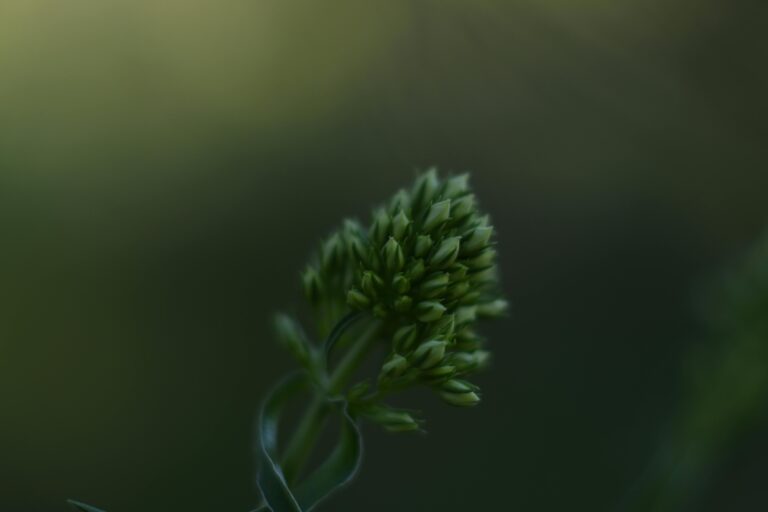
Propagation is where the magic happens. Snip a healthy stem, let the cut callous over for a day or two, and then gently nestle it into sandy soil. Patience is key – a gentle spray of water now and then, combined with warmth and indirect sunlight, encourages new roots to form. Before you know it, what started as a simple cutting from a friend’s plant can transform into an established succulent in your own garden tableau.
For further insight into Sedum Cauticola care, take a peek at this resource, which paints a vivid picture of the pleasures and ease of nurturing these delightful succulents.
Interested in diving deeper into the world of succulents? I recommend visiting The Ultimate Guide to Succulent Care, a treasure trove of tips and tricks that will aid any aspiring green thumb in crafting their own verdant paradise.
By embracing the art of planting and propagating Sedum Cauticola, not only do you foster growth in your garden but also within the community of plant lovers who cherish these resilient gems. Share your triumphs; pass along a cutting. Soon, you’ll see the beauty you’ve nurtured spread beyond your own backyard.
Care and Maintenance Tips
Imagine a resilient plant that can rise to the occasion, whether it’s perched on a rocky slope or nestled in a sun-soaked corner of your garden. This is Sedum Cauticola, your low-maintenance companion in the plant world. Our goal today? To unveil the care secrets that will let your Sedum Cauticola not just survive but thrive!
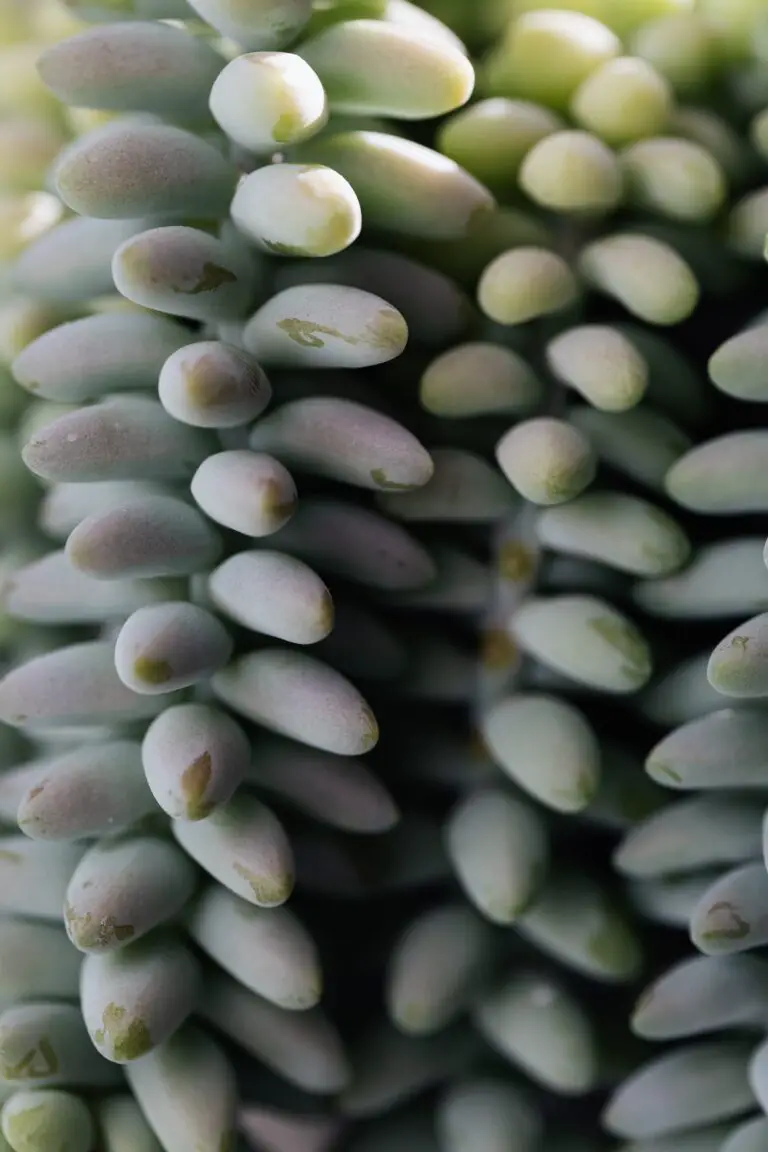
Water Wise, Be Plant Smart
First on the list is water – the essence of life but a kiss of death when in excess for the Sedum Cauticola. These plants are drought-tolerant troopers, asking you to wait until the soil is dry before offering a drink. Stick your finger into the soil, if it’s dry an inch below the surface, it’s time to water. Consider it a trust exercise with nature, one that teaches patience and timing.
The Snip and Tuck: Pruning with Purpose
Pruning isn’t just for aesthetics; it’s a health check for your Sedum. Snipping off dead or damaged leaves not only tidies up the plant but also encourages new growth. The best time to wield your garden shears? Early spring or just after flowering. Think of it as a plant spa session, where you’re giving your Sedum a new lease on life.
Nourish to Flourish: Feeding Your Sedum Cauticola
Last but not least, let’s talk about feeding. Sedum Cauticola isn’t a greedy plant, but it still enjoys a nutritious meal. A balanced, slow-release fertilizer at the start of the growing season can set the stage for a robust bloom. It’s all about giving your plant the boost it needs without overindulging it – moderation is key.
With these tips in hand, you’re all set to ensure that your Sedum Cauticola stands out in your rock garden or any corner it graces. Remember, a little care goes a long way in nurturing the unspoken bond between nature and gardener!
Designing with Sedum Cauticola
Tucked away in the nooks of natural stone or poised elegantly along a border’s edge, Sedum cauticola, commonly known as the stonecrop, is redefining garden aesthetics across the globe. This versatile succulent is a treasure trove for avid gardeners and design aficionados alike, bringing a splash of color and texture to rocky domains.
Incorporating Stonecrop into Rock Gardens
Imagine a tapestry of greenery weaving through an alpine landscape in your backyard. When it comes to rock gardens, Sedum cauticola is a winning choice, effortlessly filling crevices and cascading over boulders with its fleshy, blue-grey leaves. For a striking visual impact, plant clusters of stonecrop amidst a variety of rocks, contrasting their smooth or jagged surfaces with the softness of the succulents. The results are breathtaking—transforming an ordinary space into a living mosaic of hardy enduring charm.
Border Brilliance with Sedum Cauticola
As a border plant, Sedum cauticola truly shines. Its compact growth habit and resilience make it ideal for defining the outlines of garden beds or pathways. When positioned amid flowering perennials, stonecrop’s subtle hues and distinct form add both rhythm and harmony to garden compositions. The warm pink flowers that bloom in late summer offer a delightful bonus, drawing in a buzz of pollinators and enhancing the dynamic scene.
Ground Cover Goals
Furthermore, Sedum cauticola serves as an exquisite ground cover option, thriving even in less-than-ideal soil conditions. Its spreading habit quickly carpets areas with drought-tolerant, low maintenance foliage. Mitigating soil erosion on slopes and providing a year-round green layer, Sedum cauticola is not only aesthetically pleasing but also an ecosystem champion. It merges beauty with functionality in a way that few other plants can.
Embark on a visual journey and gather inspiration from a well-curated Sedum garden with this insightful video:
Whether you’re an amateur gardener or a seasoned landscape artist, Sedum cauticola’s robust attributes invite endless creativity. Don’t miss the chance to make this adaptable plant a standout feature in your garden story. With its resilience and low-maintenance nature, Sedum cauticola fits effortlessly into the narrative of sustainable and sophisticated garden design. Embrace the stonecrop’s potential and watch as your garden evolves into a living masterpiece!
Common Pests and Problems
When it comes to championing through the challenges of the outdoor canvas, Sedum Cauticola, a hearty perennial preferred by rock garden enthusiasts, isn’t without its trials and tribulations. Imagine, if you will, a scene of vibrant succulent leaves basking under the sun, only to find that under the surface, tiny invaders are plotting a takeover.
One such notorious nemesis is the aphid, a minuscule, sap-sucking scoundrel. They tend to amass on the undersides of leaves, forming a stealthy green brigade that can weaken your plants. Combatting these unwelcome garden guests starts with a sharp eye and an even sharper action plan. Think of it like a secret garden mission: monitor regularly, and upon first sight, deploy a blast of water to knock them off their posts or introduce ladybugs as nature’s own pest control agents.
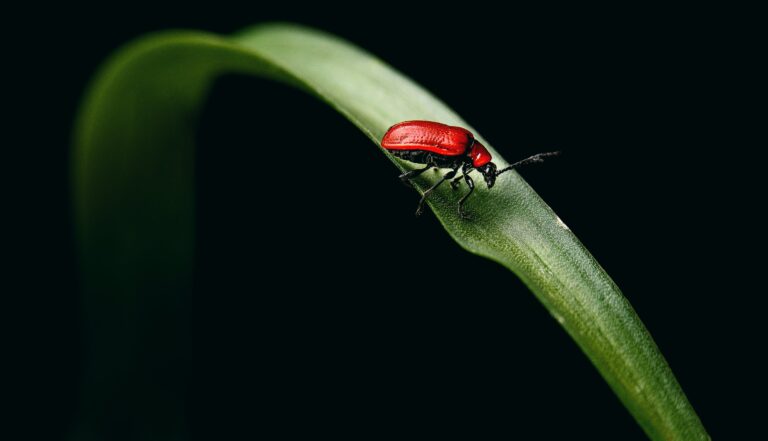
Then there’s the infamous slithery slug, an unassuming yet voracious feeder leaving its signature trail of destruction in the form of ragged leaves. Slugs are like the silent lurkers of the night—feasting under cover of darkness. To keep these slimy soirees to a minimum, circle your Sedum with defensive barriers like crushed eggshells or diatomaceous earth, which are the equivalent of an obstacle course for these garden intruders.
And let’s not forget the red scarlet lily beetle, a colorful but destructive critter shown in the photograph above. With a penchant for pillaging, they can decimate not just lilies but sedums too, turning luscious greenery into Swiss cheese lookalikes. Outsmarting them calls for vigilance; inspect leaves, pluck the beetles by hand (a task for the dedicated gardener), or apply neem oil, an organic deterrent that keeps these beetles at bay while keeping your garden’s ecosystem in check.
When diving into the world of Sedum Cauticola cultivation, it’s clear that prevention reigns supreme. Creating a robust fortress of well-draining soil and ample sunlight lays the groundwork for resistance against these common plights. However, when the pests do infiltrate, swift and strategic measures are your best line of defense to ensure your Sedum Cauticola continues to thrive, painting a picturesque scene in your rock garden, unfazed by the rascals that once threatened its vitality.
Companion Plants and Succession Planting
Creating a harmonious plant tapestry in the garden can be likened to curating a vibrant art gallery. Each plant plays a crucial role in enhancing the overall aesthetic, and this couldn’t be truer than with Sedum Cauticola, a star in the realm of rock gardens and xeriscaping. But what about the supporting cast? Let’s meet the plant pals that elevate the charm of Sedum Cauticola!
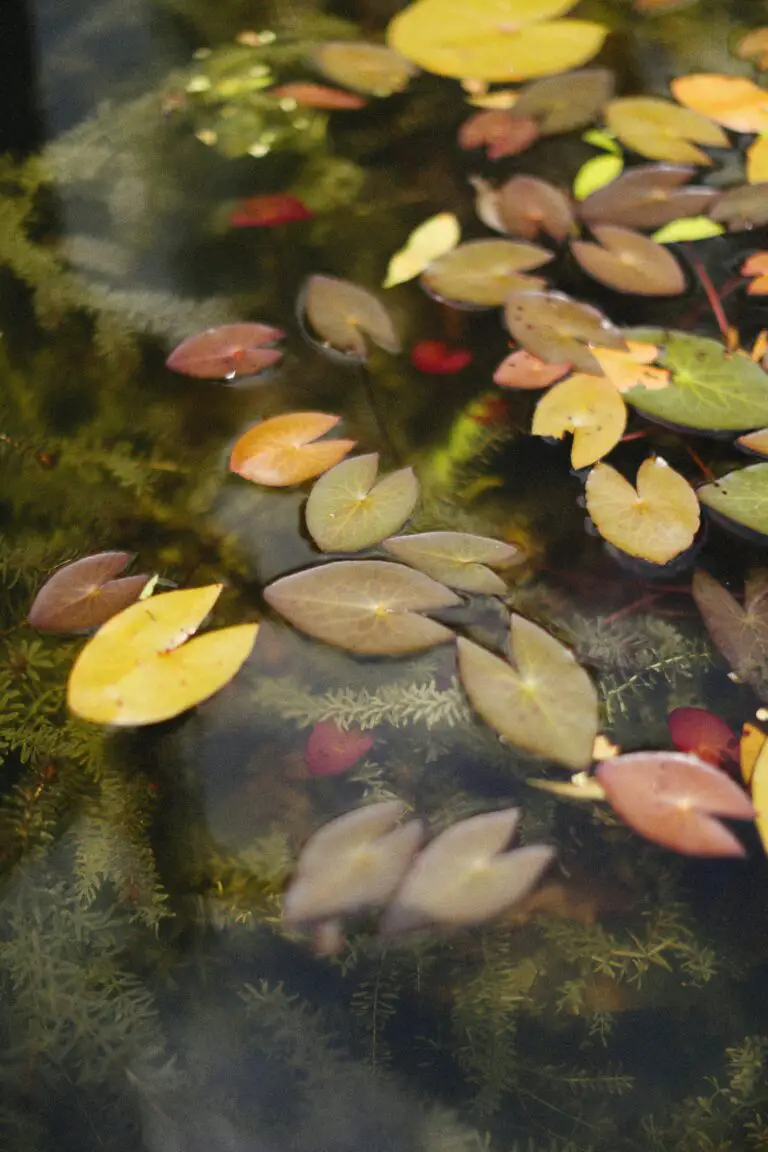
Consider the cheerful tickseed, or Coreopsis, with its sunny blooms that echo the hues of Sedum Cauticola’s flowers. Their drought tolerance makes them kindred spirits in the garden bed, sharing sips of water without overindulgence. Then there’s the feathery foliage of ornamental grasses like Blue Fescue, which underscore the sturdy yet pliable nature of our sedum.
Imagine a brisk autumn walk, the Sedum Cauticola’s fleshy leaves transitioning to a fiery crimson. Now picture it juxtaposed with the golden strands of Japanese Forest Grass, swaying gracefully in the cooling breeze. The scene is alive, not only with contrast but with congruence. And that’s the secret—finding companions that celebrate each other’s strengths throughout the seasons.
When planning for succession planting, consider the ballet of blooming. Early risers such as Crocus and Snowdrops give way to Sedum Cauticola’s verdant mounds, which then set the stage for autumnal stars like Chrysanthemums and Asters to twinkle in the waning sun. This procession ensures that not a chapter of the year goes by without a botanical highlight.
Garden Longevity: Year-Round Interest
Longevity in the garden is not mere happenstance—it’s a carefully choreographed dance of nature. To witness Sedum Cauticola in its prime, pair it with evergreens such as miniature conifers or Hens and Chicks, ensuring visual interest even as winter whispers across the landscape. Berried companions like Wintergreen and Holly offer a festive nod to the colder months, their ruby gems nestling among the sedum’s stonecrop textures.
The enduring nature of Sedum Cauticola, coupled with its versatility, invites a mosaic of companion plants that not only coexist but thrive together. Whether basking in the patriotic palette of the Fourth of July or the subdued earth tones of November’s embrace, Sedum Cauticola and its companions are a testament to the garden’s ability to capture the essence of each season and the ever-changing tapestry of life.
Environmental Benefits and Uses
Ever wandered through a rock garden and marveled at the plucky plants thriving in the craggy knolls and stone-strewn paths? Chances are high that Sedum Cauticola, the quiet superhero of the succulent world, was part of that rugged landscape. Let’s dive into the ecological treasures that Sedum Cauticola offers and its pivotal role in sustainable gardening.
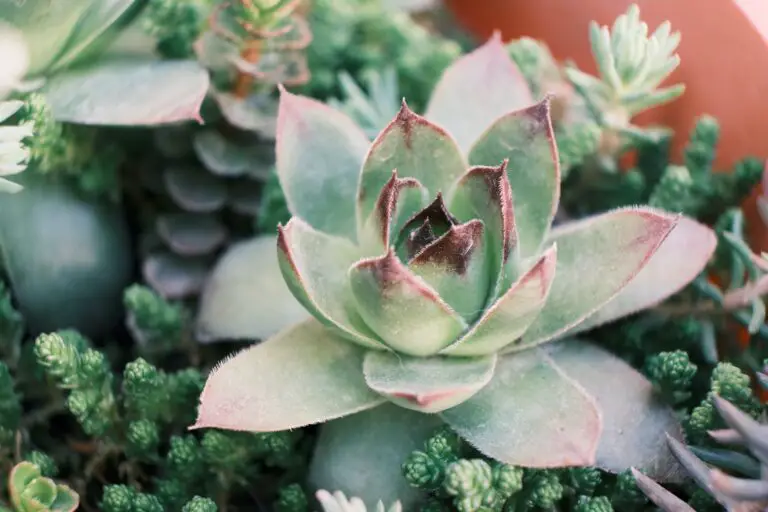
Known for its steadfast resilience, Sedum Cauticola punches way above its weight when it comes to environmental perks. This ground-covering champ doesn’t just cling to life on rocky outcrops; it helps prevent soil erosion with its dense mat of foliage. Imagine this succulent as nature’s net, anchoring the soil and defending against the erosive powers of wind and water.
A Natural Combatant Against Drought
It’s no secret that droughts are becoming more commonplace as the planet’s climate patterns shift. Enter Sedum Cauticola, a drought-resistant warrior that requires minimal water once established. By including this plant in your garden, you invest in a greener future, conserving precious water while still enjoying a garden that buzzes with life and color.
Pollinators’ Paradise
While its water conservation skills are laudable, the ecological value of Sedum Cauticola doesn’t stop there. This plant is a beacon for bees, butterflies, and other pollinators. Its nectar-rich flowers are like a 24/7 diner for these vital creatures, offering sustenance especially during the late summer to fall gap when other food sources are scarce.
Sustainable Gardening Hero
The story of sustainable gardening wouldn’t be complete without spotlighting the sustainability superhero that is Sedum Cauticola. As a low-maintenance plant that excels in poor soils and forgives the occasional forgetful gardener, it allows green thumbs to cultivate a lush garden without the heavy carbon footprint of constant upkeep and resource use.
There’s beauty in its utilitarian charm too – integrating Sedum Cauticola into green roofs, living walls, and xeriscapes not only lends aesthetic appeal but also boosts the ecological health of urban environments. Picture a sea of these succulents on city roofs, cooling buildings, and cleaning the air—one small Sedum at a time.
Frequently Asked Questions About Sedum Cauticola
If you’re eyeing that rocky nook in your garden and wondering what could possibly thrive there, meet Sedum Cauticola—your new low-maintenance gardening ally. But I see you have queries, and why wouldn’t you? Let’s dive straight into the world of these succulent wonders and clear up some common conundrums.
Can Sedum Cauticola Survive in My Climate?
Well, let’s set the scene: imagine a cliffside, rugged and exposed, where only the hardiest of plants can flourish. That’s where you’ll find Sedum Cauticola waving back at you. Native to Japan’s rocky mountain regions, this plant is a true survivor, tolerating a range of conditions, but it certainly has a soft spot for temperate zones. If your winters are harsher than a critic’s pen, fret not! This plant will often pull through, especially with well-drained soil to keep its roots from chilling in the cold.
What Kind of Soil Does Sedum Cauticola Prefer?
Imagine your garden is a dessert buffet; what dish would “Sedum Cauticola” be? Certainly not the soggy bread pudding. No, it would be the crunchy, airy meringue, demanding well-drained soils where water zips away faster than a kid dodges vegetables. So, give them that gritty, rocky, or sandy base, and they’ll settle in happier than a cat in a sunny spot.
Is Sedum Cauticola High-Maintenance?
Let’s be honest, no one enjoys needy plants. The good news? Sedum Cauticola asks less of you than a text message. It thrives on neglect—seriously. Sunlight, poor soil, occasional watering, and it’s as content as a philosopher with a good book. Plant it and practically forget it; this is the easy-listening music of the plant world.
How Do I Propagate Sedum Cauticola?
Ready to play mad scientist and multiply your Sedum Cauticola? It’s easier than baking a pie! You can take leaf cuttings or divide mature clumps, and voilà, you’ll have baby Sedums popping up like mushrooms after rain. To see them in action, check out this video for some nifty tips and tricks.
Now, are you ready to become the whisperer of Sedum Cauticola, turning your rock garden into a lush, textured tapestry? Go ahead, give these stoic beauties a whirl. They might just surprise you at how easy and rewarding they are to grow.
